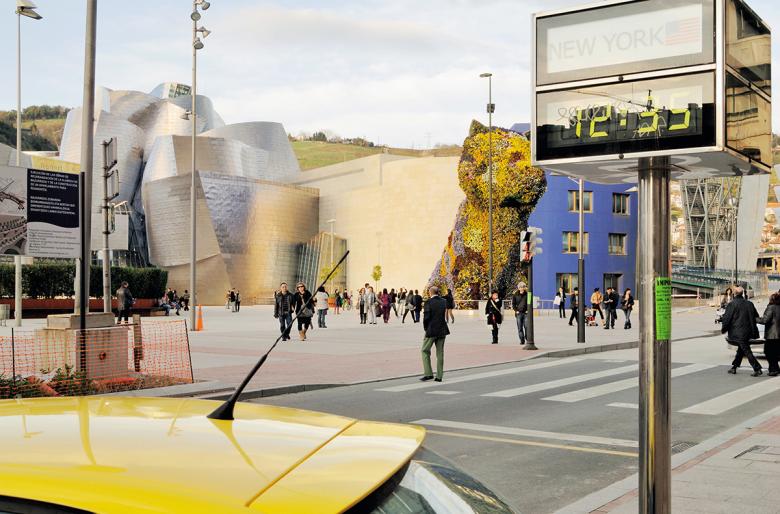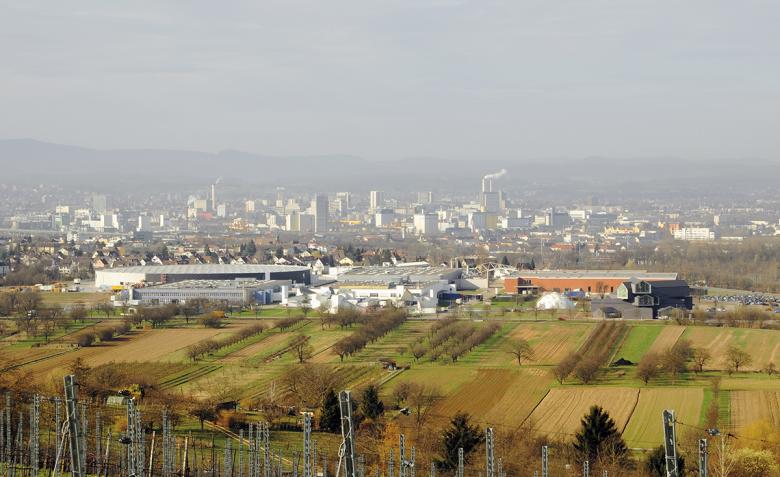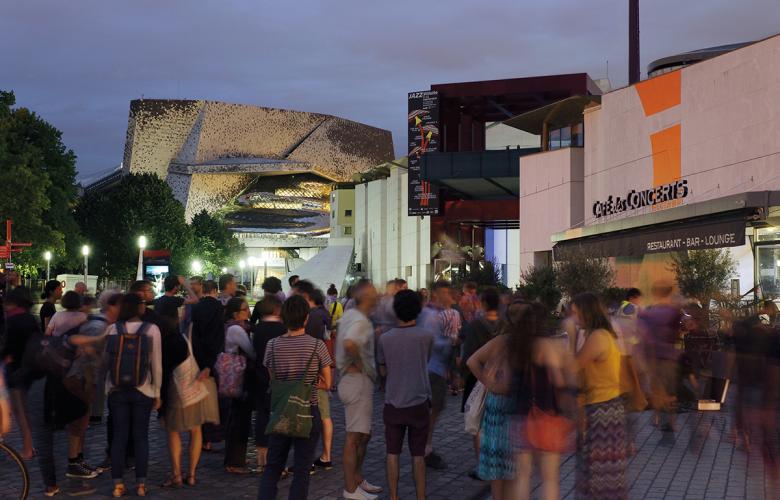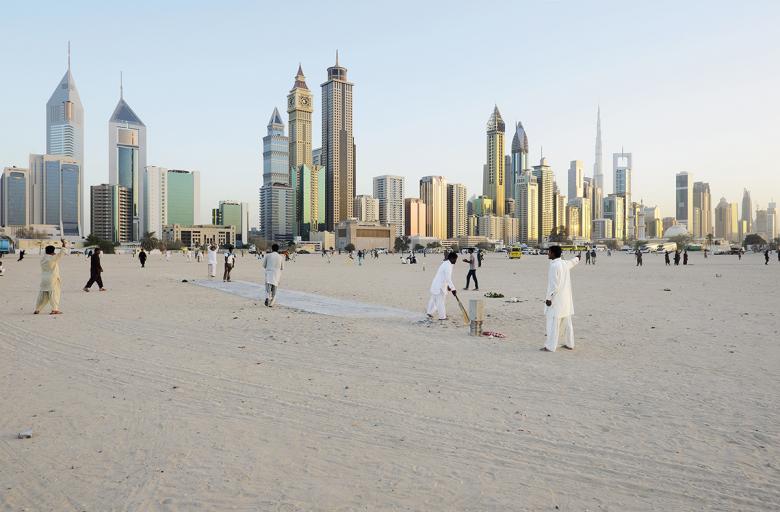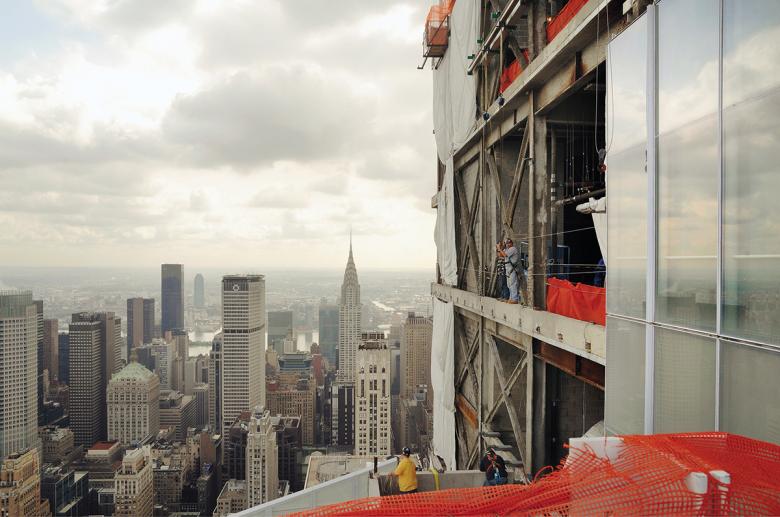Appraising Starchitecture
John Hill
8. mei 2017
Bilbao, Spain, 2010: Guggenheim Museum (Gehry Partners LLP); Puppy (Jeff Koons). Photo: Michele Nastasi
Twenty years after the "Bilbao effect" was created with the opening of Frank Gehry's Guggenheim Museum in Bilbao, Spain, the time appears to be ripe for books critiquing the plethora of architectural icons, the popularity of celebrity architects, and the changing face of cities around the world. We highlight two recently published books – The Icon Project and Starchitecture – through short interviews with their authors.
In The Icon Project: Architecture, Cities, and Capitalist Globalization, Leslie Sklair "focuses on ways in which capitalist globalization is produced and represented all over the world, especially in globalizing cities," per the Oxford University Press. Further, he "traces how the iconic buildings of our era – elaborate shopping malls, spectacular museums, and vast urban megaprojects – constitute the triumphal 'Icon Project' of contemporary global capitalism, promoting increasing inequality and hyperconsumerism."
While in Starchitecture: Scenes, Actors, and Spectacles in Contemporary Cities, Davide Ponzini "investigates projects designed by star architects in cities including Paris, New York, Abu Dhabi, Bilbao, and the architectural microcosm of the Vitra campus in Weil am Rhein, Germany," per the Monacelli Press. Davide worked with photographer Michele Nastasi (some of his photos are featured here) to "explain and critique a growing global condition by revealing how starchitecture has been and continues to be deployed in cities around the world."
Our interviews with the author are split into two sections below: three general questions to both authors, to compare and contrast their critiques, followed by three specific questions to each author about their books.
Covers of "The Icon Project" by Leslie Sklair and "Starchitecture" by Davide Ponzini and Michele Nastasi
What is the main argument of your book and how does it relate to the impact of the "Bilbao Effect" and "Iconicity" on architectural production today?
Leslie Sklair: The Icon Project argues that the almost exclusive focus of the media on iconic architecture and starchitects presents a misleading account of the industry as a whole, and that we should take the ideas of iconicity and iconic buildings more seriously. I show that these ideas are not simply inventions of the media but that the major architecture firms and many important and famous architects, architecture historians, and critics have helped to disseminate these ideas.
The idea of The Icon Project is that iconic architecture at the city, national, and global scales is part of an ideological and cultural strategy, connecting capitalist globalization and what I have called "the culture-ideology of consumerism." I define iconicity in architecture in terms of fame and symbolic/aesthetic significance which operates at the local/urban, national, and global levels. I identify three categories of iconic architects on the basis of various empirical measures, focused on their representation in the media. First, the four genuine starchitects at the beginning of the 21st century (Gehry, Foster, Hadid, and Koolhaas); second, a group of about 30 signature architects (some of whom are likely to become genuine starchitects one day). These two groups are considered to be artists, whose designs are treated as genuine works of art, and unique architectural icons when they are built. The third group is made up of those who built what I conceptualize as typical icons, buildings that reproduce some of the elements that are just about recognizable to the untrained eye as similar to unique icons. The starchitects, and to some extent the most celebrated signature architects provide the ideas that designers of typical icons copy. The Bilbao effect is shown to be a major influence in persuading urban growth coalitions that it is necessary to have an iconic spectacular building, usually designed by a famous architect, to anchor urban megaprojects in cities all over the world (just as malls have always sought big-name stores/brands). Smaller and/or less well-endowed cities make do with typical icons.
Davide Ponzini: Starchitecture is a critical appraisal of the ways in which star architecture has been interpreted, depicted and discussed in public debates. One of the ways in which the debate simplified this complex matter is the well-known "Bilbao Effect." The expectations towards designers being capable of changing the fate of one city are evidently exaggerated. In a public event for the Martha Museum in Herford he has designed, Gehry explained: "Since Bilbao people come to my office and want to hire me to do the Bilbao effect."
I suggest to look at projects, their decision-making processes and their urban effects rather than concentrating on the architectural designer’s style or persona. Under this perspective one can evidently see that a number of infrastructural investments and economic development polices other than the Guggenheim Museum contributed to the positive season of Bilbao. The icon of the museum embodied that momentum, but surely it did not cause the urban change.
Weil am Rhein, Germany, 2010: View of Vitra campus, looking toward Basel. Photo: Michele Nastasi
What are the pros and cons of the "starchitect" and his/her role in the building and branding of cities?
Sklair: The pros of the idea of the "starchitect" are that by treating globally iconic architects in the same way as celebrities in other cultural spheres (I have also researched iconicity in sports, fashion, pop culture and the arts in general), architecture is more easily represented as part of the general culture and begins to lose its taint as an esoteric art with little public interest. The cons are that by rebranding architecture in this way it can lead to an undermining of its high art status. A consequence of this, as I document in the book, is that labeling a building as "iconic" and an architect as a "starchitect" has been seen by some as a negative judgement, by others as a positive accolade. It is important to understand that my analysis of these terms is sociological, and not intended as a judgment of architectural quality. For example, as I show in the book, it is often the less famous buildings of starchitects that other architects, historians, and critics rate most highly (good examples are Foster’s Willis Faber Offices in Ipswich, the Gehry House in Santa Monica, the Koolhaas Kunsthal in Rotterdam, and Zaha Hadid’s design for the Peak Club in Hong Kong). On the question of the role of starchitects in the building and branding of cities, as I said above, the Bilbao Effect has been very important; the stardust of celebrity architecture and even the most successful typical icons rubs off onto the cities that can afford them. A less noted aspect of this which I highlight is the emergence of what I term "celebrity infrastructure" which is copied all over the world.
Ponzini: In my opinion there are no general rules. I limited myself to reflecting on the dozens of projects I’ve analyzed in cities like Paris, Abu Dhabi and New York and I could see that architects play different roles according to context and specific processes. The very same architectural firm may contribute positively to the evolution of one city’s landscape and may design questionable projects in other cities (e.g. in terms of public space, equality, …). So why not asking architects for more and better? I conclude the book by suggesting that urban policy makers and planners should take their responsibilities and have higher attention for the relationship between the new developments and the urban landscape, rather than concentrating on the brand or on the icon.
Paris, 2015: Philharmonie de Paris (Ateliers Jean Nouvel); Cité de la Musique (Christian de Portzamparc). Photo: Michele Nastasi
What do you see as the future of architectural icons? For instance, are they a fairly permanent part of architecture in cities or do you see other scenarios rising to the fore?
Sklair: The "death of the icon" has been regularly proclaimed in the professional and even in the mass media. I give examples of the "anti-icon" current in architectural culture (even Rem Koolhaas has joined, though it is difficult to decide how serious he is). My view is that despite antagonism from within the profession, the urge to build iconic buildings will persist as long as consumerist capitalism persists.
Ponzini: In the book I analyze five arguments about the end of starchitecture. Aesthetically striking interventions have been part of the built environment well before the postmodern age, and they will certainly survive throughout many eras. Despite the diverse forms of this architectural trend, we need to face its implications for today’s cities.
I try to show the power of the "starchitecture narrative" (Bilbao effect, the architect as an artist, contemporary cities conceived as collections of pieces of branded architecture, …). I believe there are other powerful narratives that now dominate the public debate on cities: think of the smart city, eco city now and the creative city just a few years ago. They work in the same way as the Bilbao effect narrative and they might substitute it in practice. But one cannot take for granted that these narratives will deliver better urban development – you have to see the so-labeled-and-marketed eco-city or smart-city projects in place and ponder their urban effects.
Singapore, 2013: View from the Skypark, Marina Bay Sands (Safdie Architects). Photo: Michele Nastasi
Most of the interviews you conducted took place in 2004; have you noticed any significant changes in regards to your subject in the intervening dozen years?
Sklair: When I began to ask questions about iconic architecture in 2004, the term was regarded with suspicion by many in and around architecture. Today many still regard it with suspicion, but most are more ready to use it, either in its positive or negative senses. In terms of the role of iconic architecture in cities and the hierarchy of global cities, the demand for new icons has intensified, even in the most successful global cities (examples include the Shard in London, Foundation Louis Vuitton in Paris, Gehry New York, the Shanghai Tower) and aspirant globalizing cities (see the images of ‘typical iconic buildings’ in chapter 3).
Your book focuses on the role of iconic architecture in capitalist globalization; do architects play an active role in this process or do they merely provide form for their clients and respective cities?
Sklair: This is a tricky question. Many architects do play an active role, some willingly and others unwillingly. More than most creative artists, architects are reliant on external financing to bring their artistic endeavors to fruition, so they don’t have much choice if they want to build big, expensive buildings. There is a good deal of controversy about this in the profession, not so much in the industry (see my section on the criticality debate in chapter 6). As I say throughout the book, I am not judging but trying to analyze: so yes, in many cases architects do play an active role in the business of capitalist globalization and in spreading the culture-ideology of consumerism.
Do you see anything that architects (those willing) could do to resist what you call the "culture-ideology of consumerism"?
Sklair: Not much, in the present global climate in which the culture-ideology of consumerism seems to rule supreme all over the world with disastrous ecological consequences. Many architects are active in the green, sustainable building arena, but here the Jevons effect kicks in. As each skyscraper becomes ‘greener and more sustainable’, the more they build, so while unit carbon footprint declines, aggregate carbon footprint increases all the time. 21st century Shanghai is an excellent example of that and in Paris, up until now a city not dominated by skyscrapers, more high towers are planned to attract the City of London financiers to come to Paris when Brexit happens. However, as I say at the end of the book, architects and urban designers will surely work to enhance our built environment on the way to a better, more sustainable future: "All types of architecture, including reimagined iconic buildings, would find a place in the new global society." An encouraging sign is that there seems to be a growing awareness in and around architecture that we are now in the Age of the Anthropocene (human behavior acting as a decisive force on the Earth system) and working out the consequences of this for architecture and building in general.
Dubai, 2012: View from Al Satwa. Photo: Michele Nastasi
Why did you select the three global cities (Abu Dhabi, New York, Paris) and how do they compare in terms of starchitecture and spectacle?
Ponzini: I selected cities with very different planning systems and ways of making decisions. Abu Dhabi is a sheikdom, Paris is a democratic city with a strong technical and political elite, New York a moderately pluralistic system. The relation between branded projects and urban planning was crucial to show the rationale and effects of starchitecture that I have investigated with the photographer and co-author Michele Nastasi.
Has much changed in regards to the subject since the 2011 publication of the first edition of Starchitecture?
Ponzini: There have been several changes in the geography of such projects, due to the different economic conditions. Several part of Europe and the West experienced a slow down, while a number of cities in the Middle East and Asia continued to grow, also using brand and spectacular architecture. I am currently studying these trends with the colleagues of the "Transnational Architecture and Urbanism" research unit at the Politecnico di Milano Department of Architecture and Urban Studies.
What are the role of Michele Nastasi's photographs in regards to the book's main arguments, and in regards to the making of the book?
Ponzini: Of course I see that Michele’s work of art made the book beautiful (at least to me and him!) and informs the reader. But, in this book, photography is not used for mere aesthetic purpose or the didactic documentation of the more than thirty projects and places observed in the research. Photography was a tool—for both Michele and myself —for critically investigating and interpreting the implications of branded projects, in particular urban contexts. Urban photography was in this sense an integral and substantial component in the methods we adopted for our research. The shooting and editing required many rounds of discussion between the two of us and many difficult decisions, but we think in the end we have distilled in this book a set of images that offers a well-documented critique of contemporary urban conditions; they portray meaningful similarities among distant urban places and contexts, while at the same time they explicitly and specifically stress problematic issues for architectural and urban design in terms of concrete effects in cities of today and the future. Michele and I are now cooperating on other research and exhibition projects using similar mix of urban studies and photography.
New York, 2008: View from the Bank of America Tower (COOK+FOX). Photo: Michele Nastasi
The Icon Project: Architecture, Cities, and Capitalist Globalization
Leslie Sklair
Oxford University Press
March 2017
Hardcover
352 Pages
Leslie Sklair is Professor Emeritus of Sociology at the London School of Economics. He worked in a cotton mill outside Glasgow for two years before going to university to study sociology and philosophy. Both experiences fostered a life-long interest in how capitalist society works in different ways for different groups of people. In particular his long-standing interest in architecture and cities sharpened his vision on the power of the built environment to shape our lives.
Starchitecture: Scenes, Actors, and Spectacles in Contemporary Cities
Davide Ponzini, Michele Nastasi
The Monacelli Press
December 2016
Hardcover
216 pages
Davide Ponzini is Associate Professor of Urban Planning at Politecnico di Milano and currently Visiting Professor at TU Munich. His research work has been published extensively, including Starchitecture with architectural photographer Michele Nastasi.
Michele Nastasi is a photographer and editor of the journal Lotus International. His photographs have been published widely in journals and books and exhibited in solo and group exhibitions in Italy and the United States.
Gerelateerde artikelen
-
Appraising Starchitecture
on 08-05-2017
